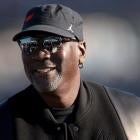
When the time came for Arsenal to set out which players might recoup the greatest fees in a summer where they would need to balance some hefty expenditure, Kieran Tierney's name would surely have figured prominently among decision makers at the Emirates Stadium. As CBS Sports revealed in January, the left back was ready to consider a future away from north London. He might have dropped down to the depth chart in 2022-23 but this was still a player of serious pedigree, one who had been on the radar of every elite club when he was at Celtic.
Since then he might have struggled with injuries and been usurped by Oleksandr Zinchenko, but when he played in the role to which he was accustomed, Tierney had proven himself to be an excellent left back. At his best, in the early years of Mikel Arteta's tenure, he functioned as something of a one man flank, his eye for a dangerous cross as effective a route to goal as the misfiring Gunners had in the early days. This is, after all, a player of sufficient talent that Scotland managers have tried a string of different systems just to get him and Andrew Robertson in the same XI.
Arsenal might well have expected a fee of around £30 million for a player with that sort of ceiling. After all, he has only just turned 26 and wages of £110,000 a week ought not to have proven too onerous for the clubs in the Premier League that seemed his natural destination. If moneybags Newcastle and free-spending Aston Villa could be drawn into a bidding war, all the better.
Instead, Arsenal are getting nothing for Tierney bar a small loan fee and his wages covered by Real Sociedad, a package that amounts to about $6 million in total. That is better than keeping hold of a player who Arteta clearly does not envisage using regularly and a good season with a Champions League club might boost his value. For Tierney himself, well a few months in one of Europe's gastronomical and cultural hotspots is nothing to be sniffed at.
Why Tierney's move matters
For a week that can be packed with drama and dollar signs, this may seem a fairly prosaic deal, but Tierney's move shines a light on some of the trends in both recruitment and tactics that are driving the transfer market. Indeed, the Scottish international's exit even touches on that great disruption point of the window, interest from Saudi Arabian clubs in Tierney emerging back in July without any realistic prospect that the Scot would move to the Pro League.
Similarly, a realistic opening never emerged for him at a Premier League club either. That reflects a market that more than ever appears to covet youth. Even inveterate sides such as Manchester City and Liverpool have brought down the average age of their squad this summer, through two weeks of the season only seven clubs deployed teams with an average age of at least 27. As transfer fees balloon, more and more clubs want the confidence that they are buying assets for the next decade.
That also means picking up players who reflect the tactical trends of where the game could be in 10 years' time. It was notable then that Newcastle, long viewed as the obvious destination for Tierney, opted not for an experienced left back who could bomb up and down the touchline, but for a midfielder-cum-left-back in Lewis Hall who might allow Eddie Howe to follow on from Pep Guardiola and Arteta in utilising an inverted full back who bolsters his midfield.
Almost every top side has experimented with this approach in the early weeks of the new season, some with greater aplomb than Manchester United. When Tierney was asked to do that by Arteta, he looked ill at ease. "It was genuinely all new to me," said Tierney in July, giving the impression that midfield was to him what the Bermuda Triangle is to pilots. "I had never played in the centre of the park before. It wasn't somewhere I ventured in very often before, so it makes you a better player learning."
Newcastle and others concluded that it might be too late and too expensive to teach Tierney on the job. And yet, the end result of several assessments of where the game is heading -- that it is best to buy young, that fullbacks need to be able to step infield -- leads to some curious overall conclusions. Is it shrewd to commit £35 million to what Hall might be as opposed to somewhat less on what Tierney is?
This summer has left one with the feeling that Tierney might just be a man out of time, the analogue full back in the digital age. And yet, the market has got so low on players such as him that Real have picked up a seasoned winner, a much admired professional and an extremely competent left back for the sort of price that might have looked like a steal 20 months ago, to say nothing of 20 years. Tierney might be throwback, but then again, throwbacks might just be a brand new market inefficiency to be exploited.






















